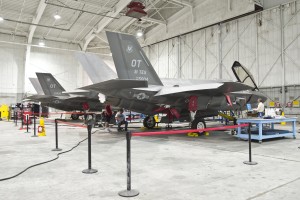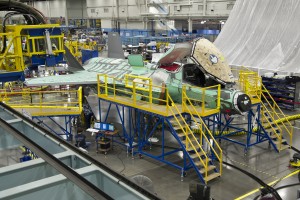2012-11-30 Earlier Second Line of Defense had a wide-ranging discussion with Don Kinard of Lockheed Martin, one of the best production specialists in the aviation business today.
In that conversation we focused on the approach to building wings for the F-35.
https://www.sldinfo.com/an-update-on-f-35-manufacturing-the-case-of-wing-assembly/
In our most recent visit to the F-35 plant, we discussed the evolving production process and its maturation.
Key subjects were:
- The role of software in production,
- the feedback from the F-35 pilots,
- the impacts of building three variants of a single aircraft on a single production line,
- and the impacts of the learning curve on building the aircraft.
We visited the plant after our time with the Marines in Yuma, so the role of pilots and operations was in the forefront of our minds and a key part of the discussion as well.
SLD: How is the production process maturing certa the end of 2012?
Kinard: We will have completed 30 F-35s in 2012. We are scheduled to build 43 next year. There are around 40-50 pilots who have now flown the aircraft and have given us very positive and important feedback on the plane.
And the software for the operation of the basic aircraft, including combat systems, is 85% fully operational.
We have delivered a total of 41aircraft right now. We’ve got about 100 in work worldwide, of which 80 are in the factory.

SLD: Could we discuss software for a moment?
Many folks don’t realize how mature and stable the software in the plane is and that is due in part to the central role which software plays in the production process. Could you discuss this aspect of the plane and its production?
Kinard: You are exactly right. Software and software maturity is central to the production process.
You don’t hear much that for the most part, software availability has is always supporting the production line. So, we have had power on software when we’ve needed it, and we’ve had flight-ready software when we needed it. We’ve had very few situations where that wasn’t the case.
We’re also seeing a lot of stabilization of our supply base via the use of common software throughout the program.
Software availability and maturity is a big deal to production.
We power up the jets in final assembly and that is software driven.
We run the jets through functional tests before they ever leave the building. Our software loads, which are done in final assembly, and the compatibility of all the systems is an important part of the production process itself.
When we get out to the run stations and we start engine runs, they’re basically validating that the aircraft and all the software works the way it’s supposed to.
So software is a huge issue for us, and software maturity is a huge issue for us.
The fact that we have many software laboratories and the fact that we have distributed avionics in the airplane has allowed those systems to mature.
On legacy programs, you couldn’t always test the radar separate from the CNI, separate from the EW, separate from whatever.
But here because of the extensive laboratories and the way the software architecture is designed, I can test the systems with suppliers, I can test them in the labs, and when I put them on the airplane, the systems work together.
I can’t move my aircraft unless all the systems and all that software work, too.
SLD: Let us talk about the learning curve and the impact of having three planes built on the same line on cross learning.

Kinard: From the manufacturing point of view, in terms of where we were with the very first aircraft, we’re down about two-thirds in touch labor. We’re a third of what we built the very first aircraft.
The commonality across the variants is an important variable in impacting on learning for each variant as well.
The missions systems are 100 percent common on all three variants. Because of this commonality we’re getting maturity a lot earlier.
If you look at the overall learning curve, we’ve actually come down, with three variants what we would call a world class, 70 percent learning curve. A learning curve means as I double the production build number (4 aircraft to 8 aircraft for example), the cost drops by 30 percent (70% of the cost).
So, the fourth aircraft is 70 percent of the second aircraft. The eighth aircraft is 70 percent of the fourth aircraft. And we’ve been coming down that curve with three variants, really, since the beginning of the program.
SLD: And the impact of cross learning across the variants?
Kinard: Because the Navy is coming in last among the three they are starting at a point in the learning curve significantly different than if they were building an aircraft just for themselves.
Because we’re building the other variants together with the CTOL, we’re getting a combined learning curve for those aircraft that you wouldn’t see if you were just building them by themselves.
If you were off in some other place, another factory, you wouldn’t have the commonality, and you wouldn’t have a learning curve. I would say that CVs are being dragged down a path by the other aircraft, down a very excellent learning curve.
And frankly, the challenge of building three variants on a single line was one, which has been significant. As a manufacturer, I was not certain that the three variants would be able to come down a common learning curve because structurally, the parts are different.
But the manufacturing plan was designed to be is the same in each station/area regardless of the variant.
And all the avionics, which are—that frankly, the costly part of the aircraft, are all common.
And with regard to the other aspects of the plane, commonality across the vehicle systems is high as well around 60%, while structural commonality is less than 20% due to the differing missions and design requirements of each variant.
SLD: Many people do not realize how much the F-35 is like an Airbus or now the evolving Boeing production model, where the final assembly line mates core subsystems and does not assemble parts. Could you discuss this aspect?
Kinard: Lockheed Martin only has about 30 percent of the program. Seventy percent of the program is out of the supply base, and so of that 30 percent, a fraction of that is actually touch labor.
It’s really not where the money is, the money is in the supply base, the avionics in particular. People are constantly talking to us about affordability and touch labor reduction.
So, it’s a very visible part of the program.
But again, I think the bottom line is we’re coming down in the amount of touch labor needed to build the aircraft—as good of learning curves as we’ve ever come down here in Fort Worth.
From the manufacturing point of view, from the very first aircraft, we’re down about two-thirds in touch labor. We’re a third of what we built the very first aircraft from a touch labor standpoint.
SLD: There are a growing number of pilots who have flown the F-35, around 50 to date. We believe that given the nature of the aircraft, the “testing” by the pilots in operations will be a significant input to the evolution of the program, especially when one considers the fact that this is a software upgradeable aircraft. What is your perspective with regard to the pilot impact?
Kinard: Unfortunately, the views of pilots are not getting as much public visibility as they should.
The reaction of the pilots has been exceptionally positive. These are no shrinking violets but they have given us a steady stream of positive feedback.
And Engineers and Pilots look at flight test differently.
Engineering thinks about it in discreet intervals of proving capabilities. That’s not the way the pilots think about it. That’s why it’s so exciting about the pilots who tell us they love it, who say hey, this is cool. And who want more. I want to fly over here, I want to do this, I want to do that. That’s the cycle, which will drive further development of the aircraft.
This is not your HUD (heads up display), this is not your dials and gauges, airplane. This aircraft is designed to give the pilot the information they need, in a helmet format, which by the way is working much better than advertised in the media per the pilot inputs.
Well, frankly I think we’re fooling ourselves, even though we have lots of pilots around here, to think that we are going to sit back in our desks here in engineering or manufacturing, understanding what that really is going to be like to fly and develop the missions and the capabilities with the technology.
Introducing a new aircraft is a process that will take time and development, which utilizes the pilots and the engineers.
During the visit, we saw several F-35Bs for the Yuma squadron(s) being built or prepared for delivery.
[slidepress gallery=’f-35-final’]

